stop start MITSUBISHI ASX 2017 (in English) User Guide
[x] Cancel search | Manufacturer: MITSUBISHI, Model Year: 2017, Model line: ASX, Model: MITSUBISHI ASX 2017Pages: 458, PDF Size: 22.98 MB
Page 139 of 458
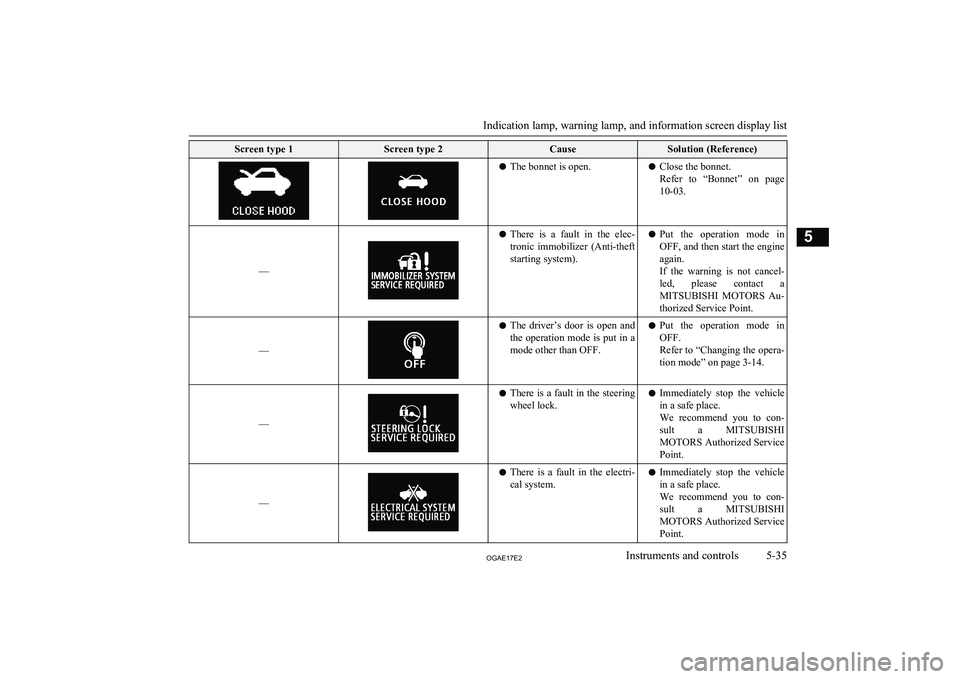
Screen type 1Screen type 2CauseSolution (Reference)lThe bonnet is open.lClose the bonnet.
Refer to “Bonnet” on page 10-03.
––
l There is a fault in the elec-
tronic immobilizer (Anti-theft
starting system).l Put the operation mode in
OFF, and then start the engine again.
If the warning is not cancel-
led, please contact a
MITSUBISHI MOTORS Au-
thorized Service Point.
––
l The driver’s door is open and
the operation mode is put in a
mode other than OFF.l Put the operation mode in
OFF.
Refer to “Changing the opera- tion mode” on page 3-14.
––
l There is a fault in the steering
wheel lock.l Immediately stop the vehicle
in a safe place.
We recommend you to con-
sult a MITSUBISHI
MOTORS Authorized Service
Point.
––
l There is a fault in the electri-
cal system.l Immediately stop the vehicle
in a safe place.
We recommend you to con-
sult a MITSUBISHI
MOTORS Authorized Service
Point.
Indication lamp, warning lamp, and information screen display list
5-35OGAE17E2Instruments and controls5
Page 144 of 458
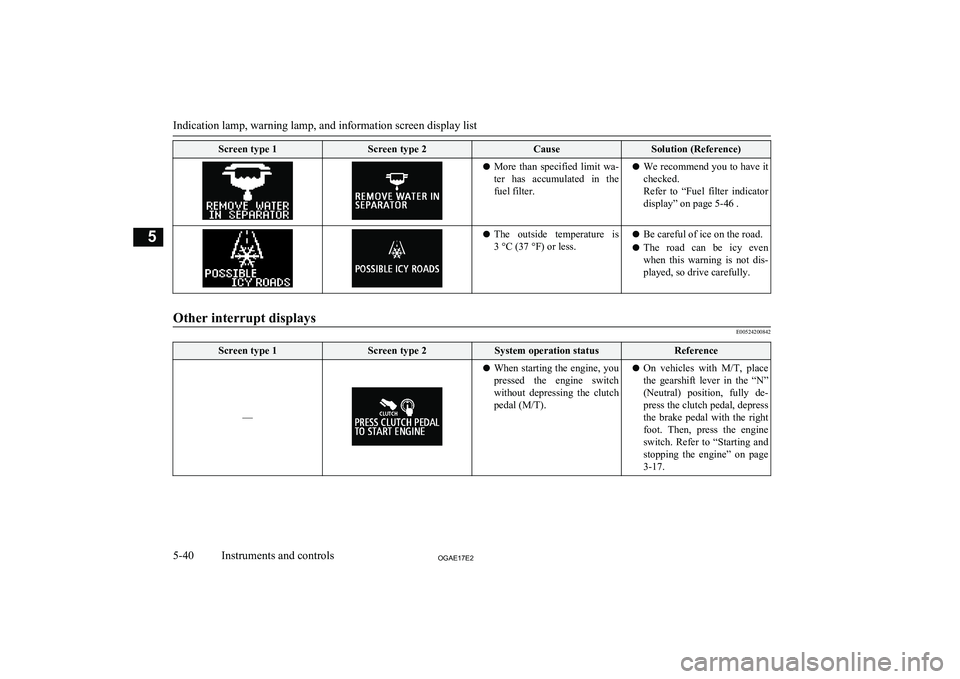
Screen type 1Screen type 2CauseSolution (Reference)lMore than specified limit wa-
ter has accumulated in the fuel filter.l We recommend you to have it
checked.
Refer to “Fuel filter indicator display” on page 5-46 .l The outside temperature is
3 °C (37 °F) or less.l Be careful of ice on the road.
l The road can be icy even
when this warning is not dis- played, so drive carefully.
Other interrupt displays
E00524200842
Screen type 1Screen type 2System operation statusReference
––
l When starting the engine, you
pressed the engine switch without depressing the clutch pedal (M/T).l On vehicles with
M/T, place
the gearshift lever in the “N” (Neutral) position, fully de- press the clutch pedal, depressthe brake pedal with the rightfoot. Then, press the engine
switch. Refer to “Starting and stopping the engine” on page
3-17.
Indication lamp, warning lamp, and information screen display list
5-40OGAE17E2Instruments and controls5
Page 145 of 458
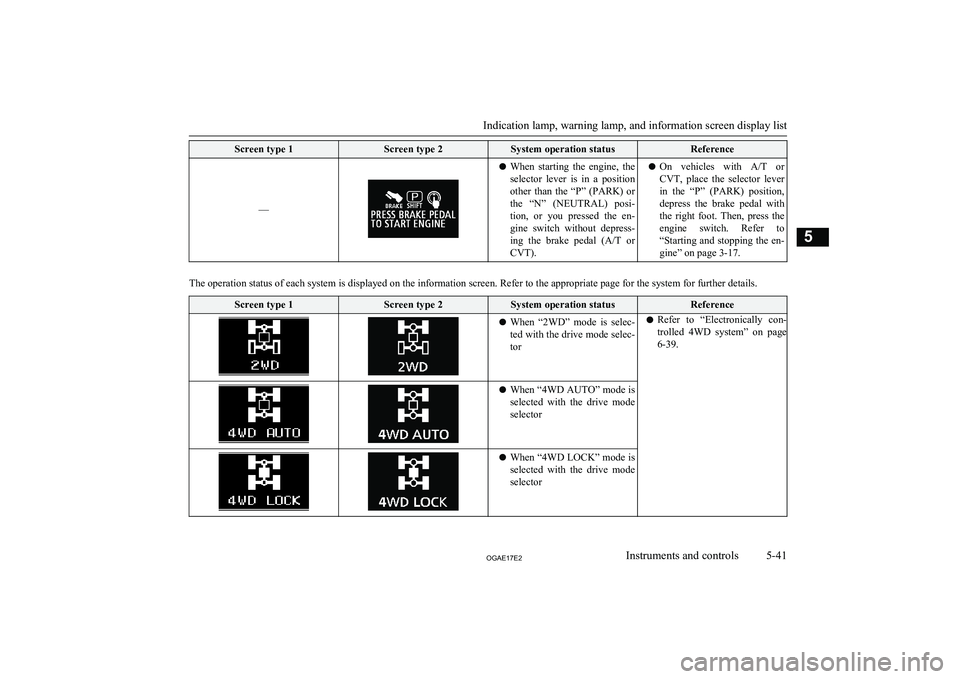
Screen type 1Screen type 2System operation statusReference
––
lWhen starting the engine, the
selector lever is in a position
other than the “P” (PARK) or
the “N” (NEUTRAL) posi- tion, or you pressed the en-
gine switch without depress-
ing the brake pedal ( A/T or
CVT).l On vehicles with
A/T or
CVT, place the selector lever in the “P” (PARK) position,
depress the brake pedal with the right foot. Then, press the
engine switch. Refer to “Starting and stopping the en- gine” on page 3-17.
The operation status of each system is displayed on the information screen. Refer to the appropriate page for the system for further details.
Screen type 1Screen type 2System operation statusReferencel When “2WD” mode is selec-
ted with the drive mode selec-torl Refer to “Electronically con-
trolled 4WD system” on page
6-39.l When “4WD AUTO” mode is
selected with the drive mode selectorl When “4WD LOCK” mode is
selected with the drive mode selector
Indication lamp, warning lamp, and information screen display list
5-41OGAE17E2Instruments and controls5
Page 147 of 458
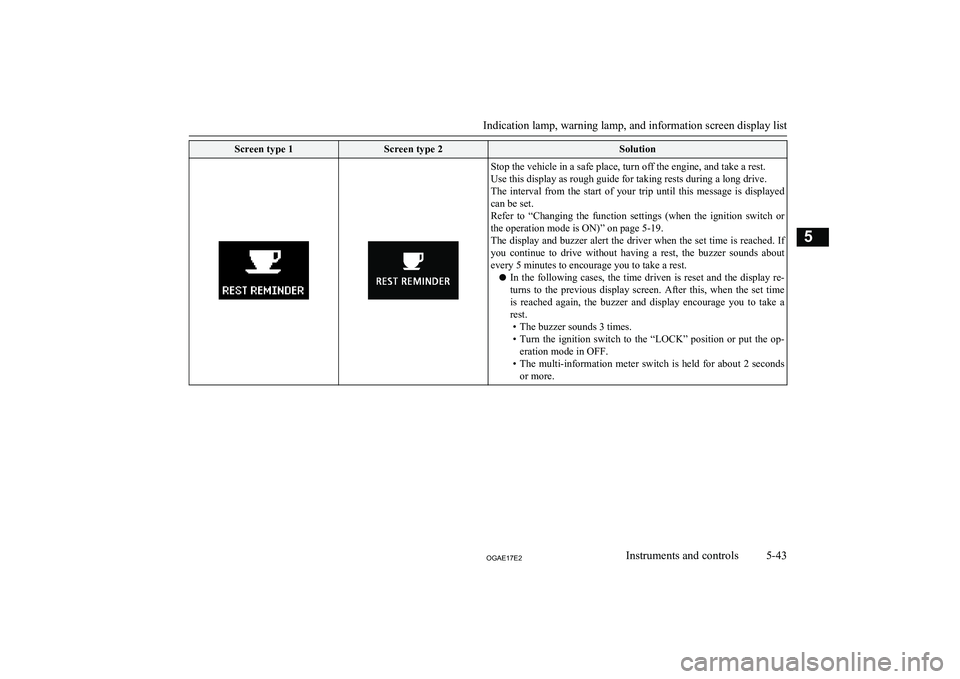
Screen type 1Screen type 2SolutionStop the vehicle in a safe place, turn off the engine, and take a rest.
Use this display as rough guide for taking rests during a long drive.
The interval from the start of your trip until this message is displayed
can be set.
Refer to “Changing the function settings (when the ignition switch or the operation mode is ON)” on page 5-19.
The display and buzzer alert the driver when the set time is reached. If you continue to drive without having a rest, the buzzer sounds about every 5 minutes to encourage you to take a rest.
l In the following cases, the time driven is reset and the display re-
turns to the previous display screen. After this, when the set time
is reached again, the buzzer and display encourage you to take a rest.
• The buzzer sounds 3 times.
• Turn the ignition switch to the “LOCK” position or put the op-
eration mode in OFF.
• The multi-information meter switch is held for about 2 seconds
or more.
Indication lamp, warning lamp, and information screen display list
5-43OGAE17E2Instruments and controls5
Page 148 of 458
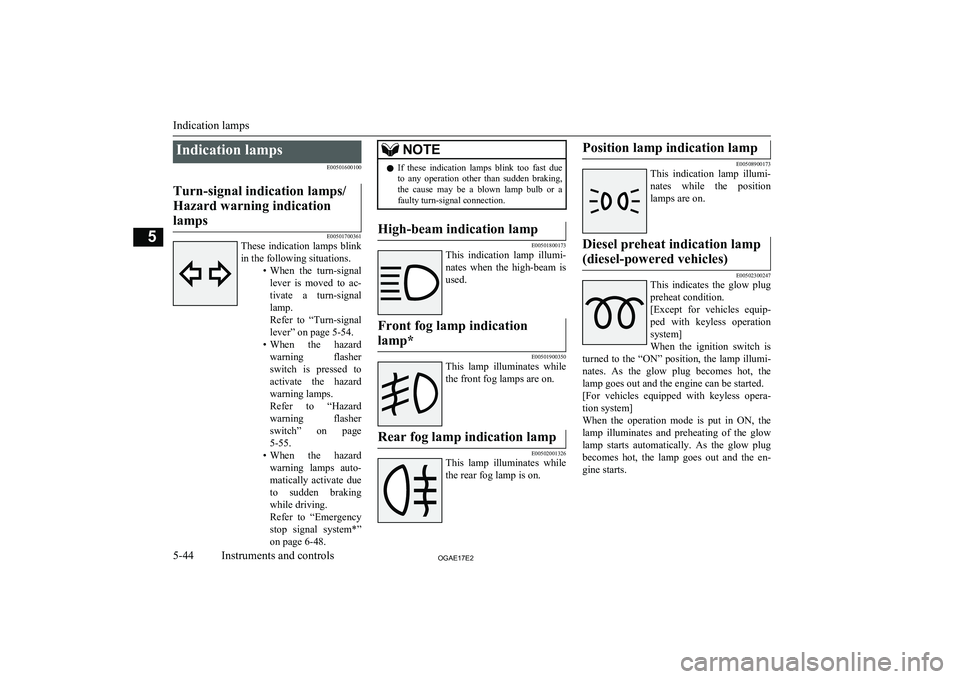
Indication lampsE00501600100Turn-signal indication lamps/
Hazard warning indication lamps
E00501700361
These indication lamps blink
in the following situations. •When the turn-signal
lever is moved to ac- tivate a turn-signal
lamp.
Refer to “Turn-signal
lever” on page 5-54.
• When the hazard
warning flasher switch is pressed toactivate the hazard
warning lamps.
Refer to “Hazard
warning flasher switch” on page
5-55.
• When the hazard
warning lamps auto- matically activate due
to sudden braking while driving.
Refer to “Emergency
stop signal system*”
on page 6-48.
NOTEl If these indication lamps blink too fast due
to any operation other than sudden braking,
the cause may be a blown lamp bulb or a faulty turn-signal connection.High-beam indication lamp
E00501800173
This indication lamp illumi-
nates when the high-beam is used.
Front fog lamp indication
lamp*
E00501900350
This lamp illuminates while the front fog lamps are on.
Rear fog lamp indication lamp
E00502001326
This lamp illuminates while
the rear fog lamp is on.
Position lamp indication lamp
E00508900173
This indication lamp illumi-
nates while the position lamps are on.
Diesel preheat indication lamp
(diesel-powered vehicles)
E00502300247
This indicates the glow plug
preheat condition.
[Except for vehicles equip-
ped with keyless operation system]
When the ignition switch is
turned to the “ON” position, the lamp illumi-
nates. As the glow plug becomes hot, the lamp goes out and the engine can be started.
[For vehicles equipped with keyless opera- tion system]
When the operation mode is put in ON, the
lamp illuminates and preheating of the glow lamp starts automatically. As the glow plugbecomes hot, the lamp goes out and the en-
gine starts.
Indication lamps
5-44OGAE17E2Instruments and controls5
Page 149 of 458
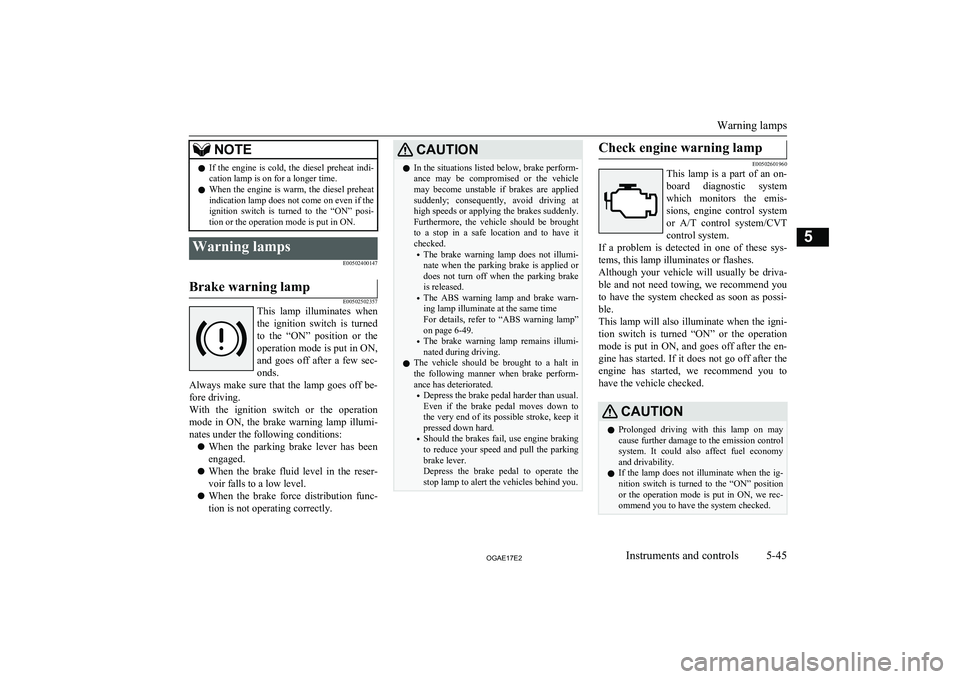
NOTElIf the engine is cold, the diesel preheat indi-
cation lamp is on for a longer time.
l When the engine is warm, the diesel preheat
indication lamp does not come on even if the
ignition switch is turned to the “ON” posi-
tion or the operation mode is put in ON.Warning lamps
E00502400147Brake warning lamp
E00502502357
This lamp illuminates whenthe ignition switch is turnedto the “ON” position or the
operation mode is put in ON, and goes off after a few sec-onds.
Always make sure that the lamp goes off be- fore driving.
With the ignition switch or the operation mode in ON, the brake warning lamp illumi-
nates under the following conditions:
l When the parking brake lever has been
engaged.
l When the brake fluid level in the reser-
voir falls to a low level.
l When the brake force distribution func-
tion is not operating correctly.
CAUTIONl In the situations listed below, brake perform-
ance may be compromised or the vehicle may become unstable if brakes are applied
suddenly; consequently, avoid driving at
high speeds or applying the brakes suddenly. Furthermore, the vehicle should be brought
to a stop in a safe location and to have it
checked.
• The brake warning lamp does not illumi-
nate when the parking brake is applied ordoes not turn off when the parking brake is released.
• The ABS warning lamp and brake warn-
ing lamp illuminate at the same time
For details, refer to “ABS warning lamp”
on page 6-49.
• The brake warning lamp remains illumi-
nated during driving.
l The vehicle should be brought to a halt in
the following manner when brake perform- ance has deteriorated.
• Depress the brake pedal harder than usual.
Even if the brake pedal moves down to
the very end of its possible stroke, keep it
pressed down hard.
• Should the brakes fail, use engine braking
to reduce your speed and pull the parking
brake lever.
Depress the brake pedal to operate the
stop lamp to alert the vehicles behind you.Check engine warning lamp
E00502601960
This lamp is a part of an on-
board diagnostic system
which monitors the emis-
sions, engine control system or A/T control system/CVT
control system.
If a problem is detected in one of these sys- tems, this lamp illuminates or flashes.Although your vehicle will usually be driva-
ble and not need towing, we recommend you
to have the system checked as soon as possi-
ble.
This lamp will also illuminate when the igni- tion switch is turned “ON” or the operation
mode is put in ON, and goes off after the en- gine has started. If it does not go off after the
engine has started, we recommend you to have the vehicle checked.
CAUTIONl Prolonged driving with this lamp on may
cause further damage to the emission control
system. It could also affect fuel economy and drivability.
l If the lamp does not illuminate when the ig-
nition switch is turned to the “ON” position
or the operation mode is put in ON, we rec- ommend you to have the system checked.
Warning lamps
5-45OGAE17E2Instruments and controls5
Page 155 of 458
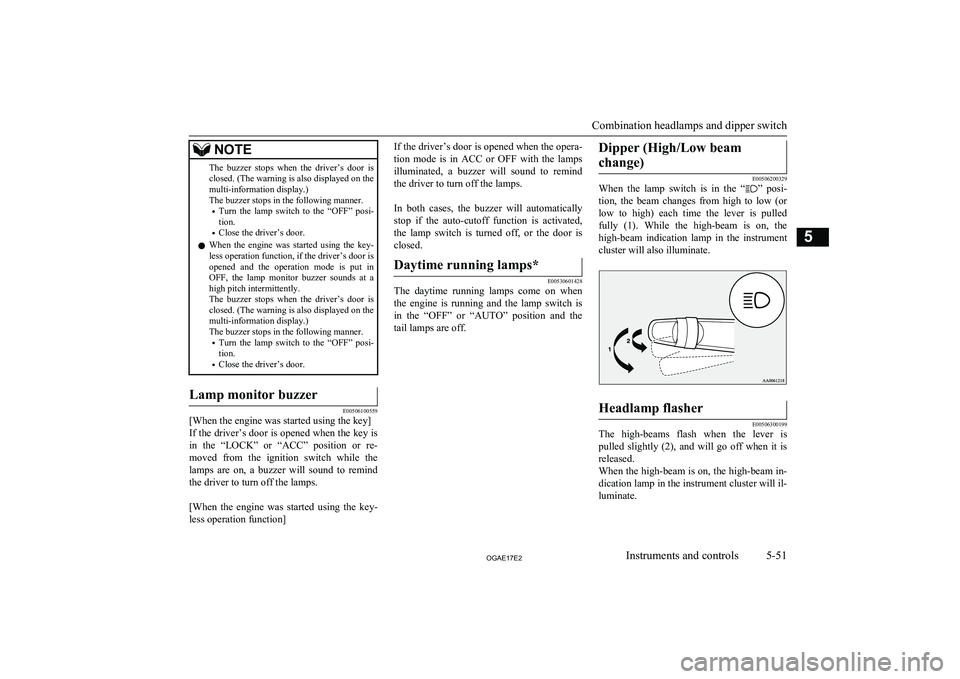
NOTEThe buzzer stops when the driver’s door isclosed. (The warning is also displayed on the
multi-information display.)
The buzzer stops in the following manner.
• Turn the lamp switch to the “OFF” posi-
tion.
• Close the driver’s door.
l When the engine was started using the key-
less operation function, if the driver’s door is
opened and the operation mode is put in OFF, the lamp monitor buzzer sounds at a high pitch intermittently.
The buzzer stops when the driver’s door is closed. (The warning is also displayed on the
multi-information display.)
The buzzer stops in the following manner.
• Turn the lamp switch to the “OFF” posi-
tion.
• Close the driver’s door.Lamp monitor buzzer
E00506100559
[When the engine was started using the key]
If the driver’s door is opened when the key is
in the “LOCK” or “ACC” position or re-
moved from the ignition switch while the
lamps are on, a buzzer will sound to remind the driver to turn off the lamps.
[When the engine was started using the key-
less operation function]
If the driver’s door is opened when the opera-
tion mode is in ACC or OFF with the lamps
illuminated, a buzzer will sound to remind the driver to turn off the lamps.
In both cases, the buzzer will automatically
stop if the auto-cutoff function is activated, the lamp switch is turned off, or the door is
closed.Daytime running lamps*
E00530601428
The daytime running lamps come on when
the engine is running and the lamp switch is in the “OFF” or “AUTO” position and the
tail lamps are off.
Dipper (High/Low beam
change)
E00506200329
When the lamp switch is in the “” posi-
tion, the beam changes from high to low (or
low to high) each time the lever is pulled fully (1). While the high-beam is on, the
high-beam indication lamp in the instrument
cluster will also illuminate.
Headlamp flasher
E00506300199
The high-beams flash when the lever is pulled slightly (2), and will go off when it is
released.
When the high-beam is on, the high-beam in- dication lamp in the instrument cluster will il-
luminate.
Combination headlamps and dipper switch
5-51OGAE17E2Instruments and controls5
Page 166 of 458

Precautions to observe whenusing wipers and washers
E00507601444
l If the moving wipers become blocked
partway through a sweep by ice or other deposits on the glass, the wipers maytemporarily stop operating to prevent the
motor from overheating. In this case,
park the vehicle in a safe place, turn the ignition switch to the “LOCK” position
or put the operation mode in OFF, and
then remove the ice or other deposits.The wipers will start operating again af- ter the wiper motor cools down, so
check that the wipers operate before us-
ing them.
l Do not use the wipers when the glass is
dry.
They may scratch the glass surface and the blades wear out prematurely.
l Before using the wipers in cold weather,
check that the wiper blades are not fro-zen onto the glass. The motor may burn
out if the wipers are used with the blades
frozen onto the glass.
l Avoid using the washer continuously for
more than 20 seconds. Do not operate the washer when the fluid reservoir isempty.
Otherwise, the motor may burn out.
l Periodically check the level of washer
fluid in the reservoir and refill if re-
quired.
During cold weather, add a recommen- ded washer solution that will not freeze
in the washer reservoir. Failure to do so
could result in loss of washer function and frost damage to the system compo- nents.Rear window demister
switch E00507901186
The rear window demister switch can be op-erated when the engine is running.
Push the switch to turn on the rear window
demister. It will be turned off automatically
in about 20 minutes. To turn off the demister
within about 20 minutes, push the switch again.
The indication lamp (A) will illuminate while
the demister is on.NOTEl When the rear window demister switch is
pressed, the outside rear-view mirrors are
defogged or defrosted. Refer to “Heated mir-
ror” on page 6-12.
l The demister switch is not to melt snow but
to clear mist.
Remove snow before use of the demister
switch.
l When cleaning the inside of the rear win-
dow, use a soft cloth and wipe gently along
the heater wires, being careful not to damage the wires.
l Do not allow objects to touch the inside of
the rear window glass, damaged or broken wires may result.
Rear window demister switch
5-62OGAE17E2Instruments and controls5
Page 169 of 458
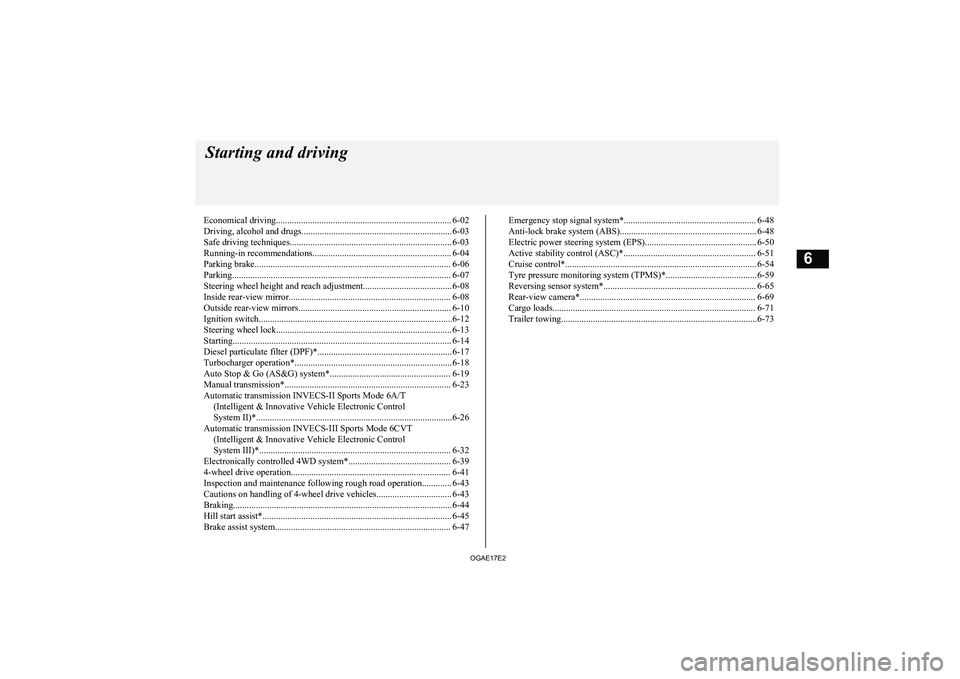
Economical driving............................................................................. 6-02
Driving, alcohol and drugs.................................................................. 6-03
Safe driving techniques....................................................................... 6-03
Running-in recommendations............................................................. 6-04 Parking brake...................................................................................... 6-06
Parking................................................................................................ 6-07
Steering wheel height and reach adjustment....................................... 6-08
Inside rear-view mirror....................................................................... 6-08 Outside rear-view mirrors................................................................... 6-10
Ignition switch.....................................................................................6-12 Steering wheel lock............................................................................. 6-13
Starting................................................................................................ 6-14 Diesel particulate filter (DPF)*........................................................... 6-17Turbocharger operation*..................................................................... 6-18Auto Stop & Go (AS&G) system*..................................................... 6-19
Manual transmission*......................................................................... 6-23 Automatic transmission INVECS-II Sports Mode 6A/T (Intelligent & Innovative Vehicle Electronic Control
System II)*......................................................................................6-26
Automatic transmission INVECS-III Sports Mode 6CVT (Intelligent & Innovative Vehicle Electronic Control
System III)*.................................................................................... 6-32
Electronically controlled 4WD system*............................................. 6-39 4-wheel drive operation...................................................................... 6-41
Inspection and maintenance following rough road operation............. 6-43
Cautions on handling of 4-wheel drive vehicles................................. 6-43
Braking................................................................................................ 6-44
Hill start assist*................................................................................... 6-45
Brake assist system............................................................................. 6-47Emergency stop signal system*.......................................................... 6-48
Anti-lock brake system (ABS)............................................................ 6-48
Electric power steering system (EPS)................................................. 6-50 Active stability control (ASC)*.......................................................... 6-51Cruise control*.................................................................................... 6-54
Tyre pressure monitoring system (TPMS)*........................................ 6-59 Reversing sensor system*................................................................... 6-65
Rear-view camera*............................................................................. 6-69 Cargo loads......................................................................................... 6-71Trailer towing......................................................................................6-73Starting and driving
OGAE17E26
Page 170 of 458
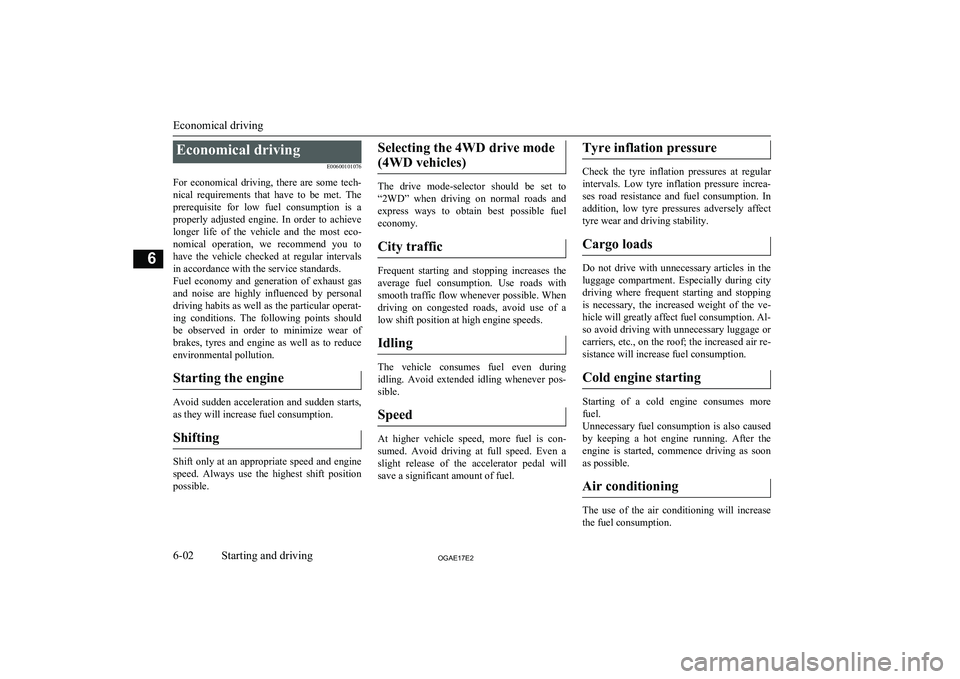
Economical drivingE00600101076
For economical driving, there are some tech- nical requirements that have to be met. Theprerequisite for low fuel consumption is a
properly adjusted engine. In order to achieve longer life of the vehicle and the most eco- nomical operation, we recommend you tohave the vehicle checked at regular intervals in accordance with the service standards.
Fuel economy and generation of exhaust gas
and noise are highly influenced by personal
driving habits as well as the particular operat- ing conditions. The following points shouldbe observed in order to minimize wear of
brakes, tyres and engine as well as to reduce
environmental pollution.
Starting the engine
Avoid sudden acceleration and sudden starts,
as they will increase fuel consumption.
Shifting
Shift only at an appropriate speed and engine speed. Always use the highest shift position
possible.
Selecting the 4WD drive mode
(4WD vehicles)
The drive mode-selector should be set to
“2WD” when driving on normal roads and
express ways to obtain best possible fuel
economy.
City traffic
Frequent starting and stopping increases the
average fuel consumption. Use roads with smooth traffic flow whenever possible. When driving on congested roads, avoid use of a
low shift position at high engine speeds.
Idling
The vehicle consumes fuel even during
idling. Avoid extended idling whenever pos- sible.
Speed
At higher vehicle speed, more fuel is con- sumed. Avoid driving at full speed. Even a
slight release of the accelerator pedal will save a significant amount of fuel.
Tyre inflation pressure
Check the tyre inflation pressures at regular
intervals. Low tyre inflation pressure increa-ses road resistance and fuel consumption. In addition, low tyre pressures adversely affect
tyre wear and driving stability.
Cargo loads
Do not drive with unnecessary articles in the
luggage compartment. Especially during city
driving where frequent starting and stopping is necessary, the increased weight of the ve-
hicle will greatly affect fuel consumption. Al-
so avoid driving with unnecessary luggage or carriers, etc., on the roof; the increased air re- sistance will increase fuel consumption.
Cold engine starting
Starting of a cold engine consumes more fuel.
Unnecessary fuel consumption is also caused by keeping a hot engine running. After the
engine is started, commence driving as soon
as possible.
Air conditioning
The use of the air conditioning will increase the fuel consumption.
Economical driving
6-02OGAE17E2Starting and driving6